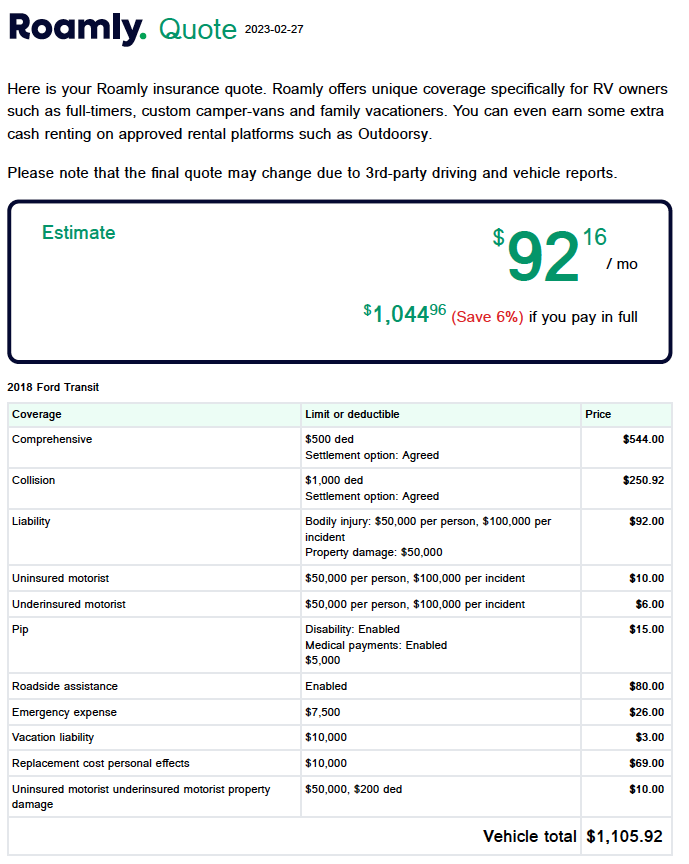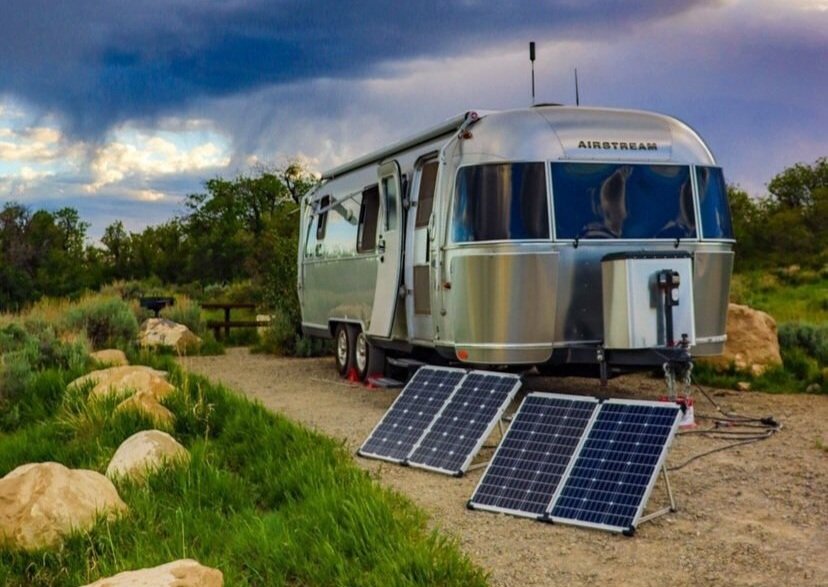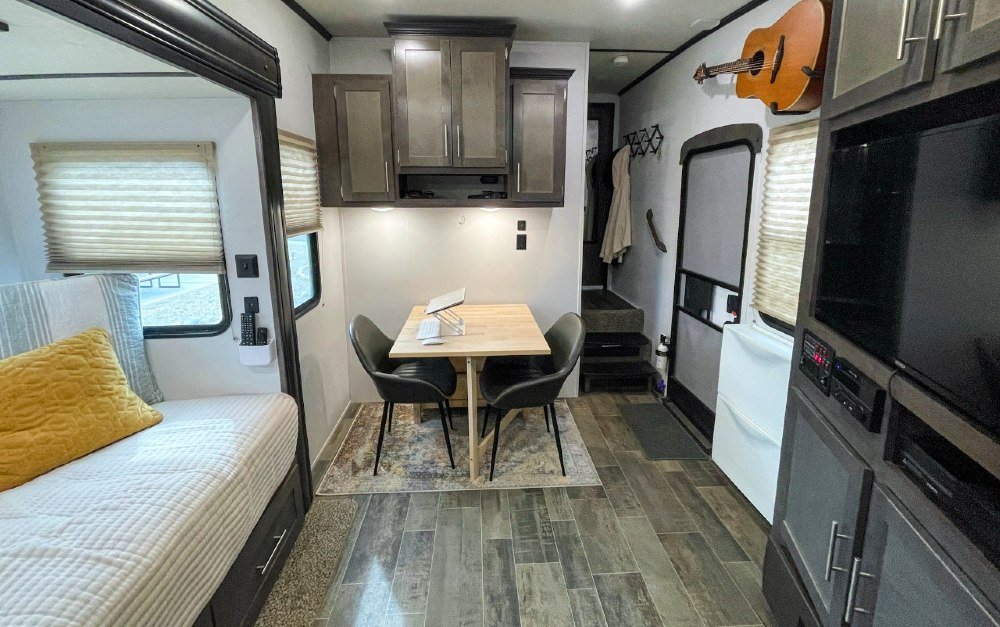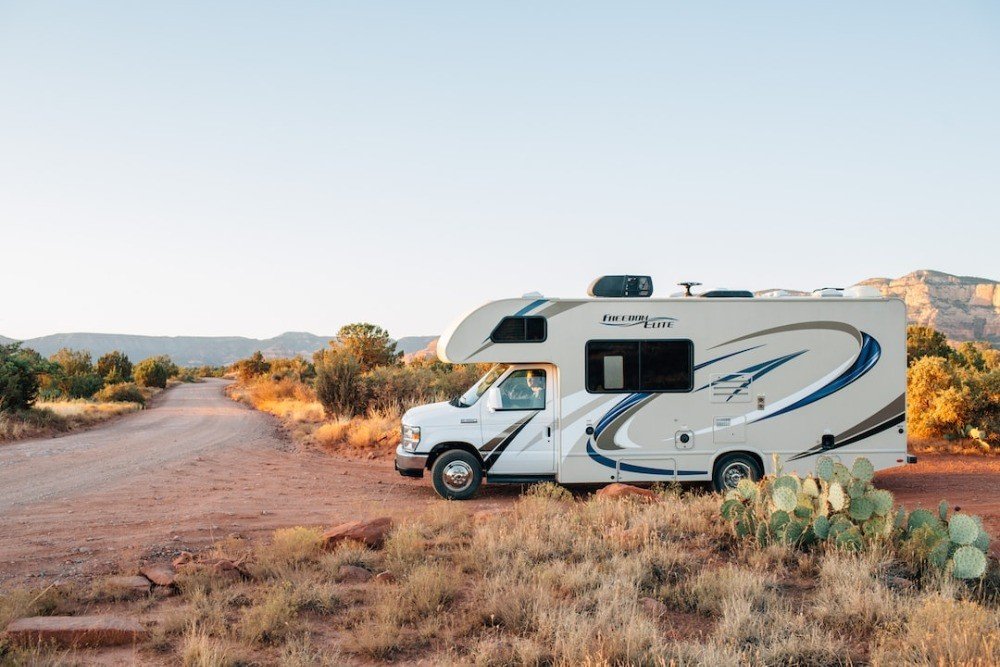Pro Tips for RV Insurance in 2024
There are several factors that go into the cost of RV insurance such as how old the RV is, the type of RV (drivable vs towable), where the RV is located, and if you plan to live in your RV full-time or for vacation only.
Surprisingly, going from full-time RV living to part-time, we didn’t see much of a decrease in our insurance premium. The most significant increase in our RV insurance occurred when we moved from California to Arkansas.
This guide will help you determine how much RV insurance costs, the best RV insurance based on customer reviews, and how to get the cheapest rates on RV insurance.
-
RV Insurance Costs (averages)
Types of RV Insurance
Best RV Insurance Providers
How to Save Money on RV Insurance
RV Insurance Cost Examples
Basics of RV Insurance
Similar to auto insurance, the most basic RV insurance coverage is liability and it only covers damages or injuries you cause to other people or their property while driving your RV.
Most states are going to require that all motorhomes (drivable RVs) at least carry liability coverage. In some states, it is not required to have insurance for travel trailers, fifth wheels, or pop-up campers.
If you are financing your RV, the lender will require you to carry coverage on the RV.
Cost of RV Insurance
The cost of RV insurance can vary greatly depending on the value of the RV, the level of coverage, and where it is primarily located.
As a rough estimate, the average cost of RV insurance for part-time use on a travel trailer is around $200 to $500 per year.
And Class A motorhome insurance costs about $1000-$2000 a year.
This is mostly due to Class As typically being far more expensive than travel trailers.
Additionally, if the same travel trailer is used for full-time living, the average cost of insurance is around $800 to $1,500 per year.
Types of RV Insurance
RV insurance coverage is similar to auto insurance, but not the exact same. You’ll see key insurance terms like comprehensive and collision coverage, but you’ll also need to decide coverage for personal property and emergency expenses.
Here are the most common terms of RV insurance:
Liability: liability insurance is required in most states and covers damages or injuries you cause to other people or their property while driving your RV.
Collision: This coverage pays for damages to your RV if it is involved in a collision with another vehicle or object.
Comprehensive: This coverage protects your RV against damage caused by non-collision events, such as theft, vandalism, fire, or natural disasters.
Personal effects: This coverage protects your personal belongings inside the RV, such as clothing, electronics, and appliances.
Vacation Liability: If someone is hurt in or around your RV while you’re on vacation, you’ll have liability coverage up to $10,000 (typically for part-time use only).
Emergency Expenses: Pays transportation and hotel expenses if your RV breaks down while using it.
Full-timer's insurance: If you use your RV as your primary residence, you will want full-timer's insurance, which provides more comprehensive coverage for your RV and its contents.
Best RV Insurance
Below you will find a short list of the best-reviewed and rated RV insurance providers across the internet.
We highly recommend getting a quote from at least 3 different providers to compare costs. While we haven’t personally used every single one of these providers, we have used Progressive, USAA, and Roamly (all of which we do recommend).
Progressive: the most common RV insurance provider is Progressive because of their nationwide coverage and very competitive rates. We used them for 2 years while we traveled full-time in our fifth wheel and had a great experience using them.
USAA: now uses Progressive for both part-time and full-time RVers, and you’ll get a bonus discount for being a USAA member.
Roamly: a newer RV insurance company that we now use and love is Roamly. They are owned by the popular RV rental company Outdoorsy.
We found Roamly originally because our conversion van couldn’t be insured with Progressive. Turns out their rates are just as competitive as the nationwide companies (if not better) and the coverage is more inclusive. Plus, their customer service has been incredible!GEICO: it’s no surprise this nationwide insurance also offers RV insurance as well for both part-time and full-timers. If you already are insured with them you will also get a discount by adding RV coverage.
All-State: similar to GEICO, I recommend getting a quick quote from them online, especially if you already have home or auto insurance with All-State.
Good Sam: what started out as a membership group for those frequenting RV parks, now also offers RV insurance, roadside assistance, and travel insurance. Honestly, even if you don’t get their insurance, we love being a member of Good Sam to get the 5-10% at most RV parks.
Your Local Insurance: sometimes the best deals are actually with a smaller and local insurance company in your area. You can either look on google or google maps to find who is in your area and see reviews from those nearby.
➔ Read next: 30+ Essential RV Accessories
How to Save Money on RV Insurance
Here are some tips to help you save money on RV insurance:
Shop around: Get quotes from multiple insurance providers and compare their rates and coverage options.
Bundle your policies: Many insurance companies offer discounts if you bundle your RV insurance with other policies, such as your home or auto insurance.
Speak with a rep: sometimes actually speaking with a live representative can offer you more discounts that aren’t shown online.
Read the fine details: for example, we commonly camp on dirt roads and learned that most RV insurers will not provide a tow if you are more than 100 feet from a major road. Another reason we have loved using Roamly is they do not have this exclusion.
Increase your deductible: A higher deductible can lower your premium, but make sure you can afford to pay the deductible if you need to make a claim.
Location: If you are getting full-time RV insurance, make sure you are putting the location of where the RV is primarily vs where your mailing address is. We save hundreds of dollars by stating we primarily had our RV in California vs in our home state of Arkansas.
Maintain a good driving record: Just like auto, your driving history can impact your insurance rates, so drive safely and responsibly.
Use your RV seasonally: If you only use your RV for part of the year, consider getting a policy that allows you to suspend coverage during the months when it's not in use.
Original owner: most of the time if you're the original owner of your RV you will receive an additional discount on your policy.
RV Insurance Examples
Here are examples of the cost and insurance terms of our RV insurance from Progressive vs Roamly.
We also show the quoted difference in cost for full-time living vs part-time use of an RV as well as how much we save from the RV residing in San Diego, CA vs Arkansas.
As you can see below, the cost of RV insurance significantly is impacted (at least for Progressive) by the location your RV is typically residing.
The first two screenshots are for part-time RV insurance when located in Arkansas where they are serious weather conditions like tornadoes, hail, and flooding versus San Diego where there are rarely any weather hazards and a very mild climate.
Everything else on these examples for Progressive are the same: a new 2022 Crossroads 31’ travel trailer that cost $35,000.
The last example is from Roamly RV and the coverage for the 2018 Ford Transit conversion van that we own. This is for coverage in Arkansas for part-time use.
I highly recommend going on at least Progressive and Roamly to get a quick quote for any RV you are planning to buy. It’s very quick and easy!
Final Thoughts:
It's important to note that the cost of RV insurance can vary widely based on several factors, including the specific make and model of the trailer, the level of coverage, and the driver's age, driving history, and location.
It's always a good idea to shop around and compare quotes from multiple insurance providers to find the best coverage and rates for your specific needs.













